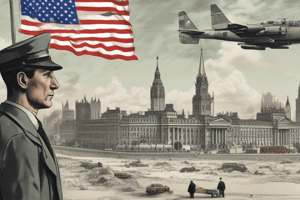Podcast
Questions and Answers
What was the primary cause of the emergence of the Cold War?
What was the primary cause of the emergence of the Cold War?
- The two superpowers had differing ideologies (correct)
- The United States and the Soviet Union had a long history of conflict
- The Soviet Union's invasion of Poland in 1939
- The United States' refusal to provide economic aid to the Soviet Union
What was the main issue of contention between the US and USSR at the Yalta and Potsdam Conferences?
What was the main issue of contention between the US and USSR at the Yalta and Potsdam Conferences?
- The creation of a unified Germany
- The fate of Japan after World War II
- The role of the United Nations in post-war reconstruction
- The division of power in Eastern Europe (correct)
What was the primary goal of the United States' policy of containment?
What was the primary goal of the United States' policy of containment?
- To promote the spread of democracy around the world
- To establish a communist government in Eastern Europe
- To create a new world order with the United States as the dominant power
- To prevent further Soviet expansion and secure its borders (correct)
What was the purpose of the Marshall Plan?
What was the purpose of the Marshall Plan?
What was the main ideological difference between the United States and the Soviet Union?
What was the main ideological difference between the United States and the Soviet Union?
What was the Soviet Union's goal in creating the Eastern European communist bloc?
What was the Soviet Union's goal in creating the Eastern European communist bloc?
The Potsdam Conference led to a unified agreement on post-war reorganization among the Allied leaders.
The Potsdam Conference led to a unified agreement on post-war reorganization among the Allied leaders.
The Truman Doctrine was a policy of non-intervention in the face of communist expansion.
The Truman Doctrine was a policy of non-intervention in the face of communist expansion.
The Marshall Plan was a joint economic aid package offered by the US and the USSR to war-torn Europe.
The Marshall Plan was a joint economic aid package offered by the US and the USSR to war-torn Europe.
The fall of the Berlin Wall marked the beginning of the end of communist regimes in Western Europe.
The fall of the Berlin Wall marked the beginning of the end of communist regimes in Western Europe.
Mikhail Gorbachev's reforms, Perestroika and Glasnost, aimed to strengthen the Soviet economy and increase secrecy.
Mikhail Gorbachev's reforms, Perestroika and Glasnost, aimed to strengthen the Soviet economy and increase secrecy.
The period of détente in the 1960s-1980s was marked by increased tensions and arms races between the US and the USSR.
The period of détente in the 1960s-1980s was marked by increased tensions and arms races between the US and the USSR.
Flashcards are hidden until you start studying
Study Notes
Origins of the Cold War
Post-WWII Tensions
- The Cold War emerged from the tensions between the United States and the Soviet Union after WWII.
- The two superpowers had differing ideologies, economic systems, and visions for the post-war world.
Yalta and Potsdam Conferences
- The Yalta Conference (1945) and Potsdam Conference (1945) were held to discuss post-war reorganization and reconstruction.
- The conferences highlighted the growing divisions between the US and USSR, particularly over issues like:
- Soviet control of Eastern Europe
- Reparations and demilitarization of Germany
- The role of the United Nations
Soviet Expansion and US Containment
- The Soviet Union sought to expand its influence and secure its borders through:
- Creation of the Eastern European communist bloc
- Occupation of Eastern Germany and Austria
- Support for communist movements in Greece and Turkey
- The United States adopted a policy of containment, aiming to prevent further Soviet expansion through:
- Economic aid to Europe (Marshall Plan)
- Military alliances (NATO)
- Support for anti-communist movements and governments
Ideological Differences
- The Cold War was also fueled by fundamental ideological differences between the US and USSR:
- Capitalism vs. Communism
- Democracy vs. Authoritarianism
- Free markets vs. Centralized planning
Early Crises and Incidents
- The Cold War was marked by early crises and incidents, including:
- The Soviet blockade of Berlin (1948-1949)
- The formation of the Eastern European communist bloc (Cominform, 1947)
- The Czechoslovakian coup (1948)
Studying That Suits You
Use AI to generate personalized quizzes and flashcards to suit your learning preferences.




